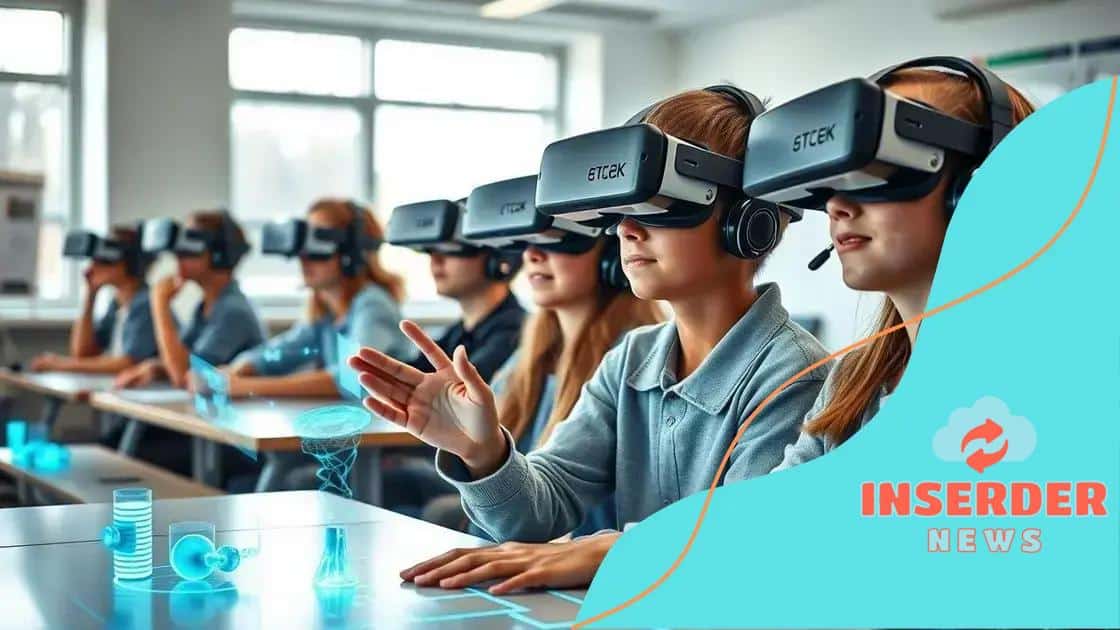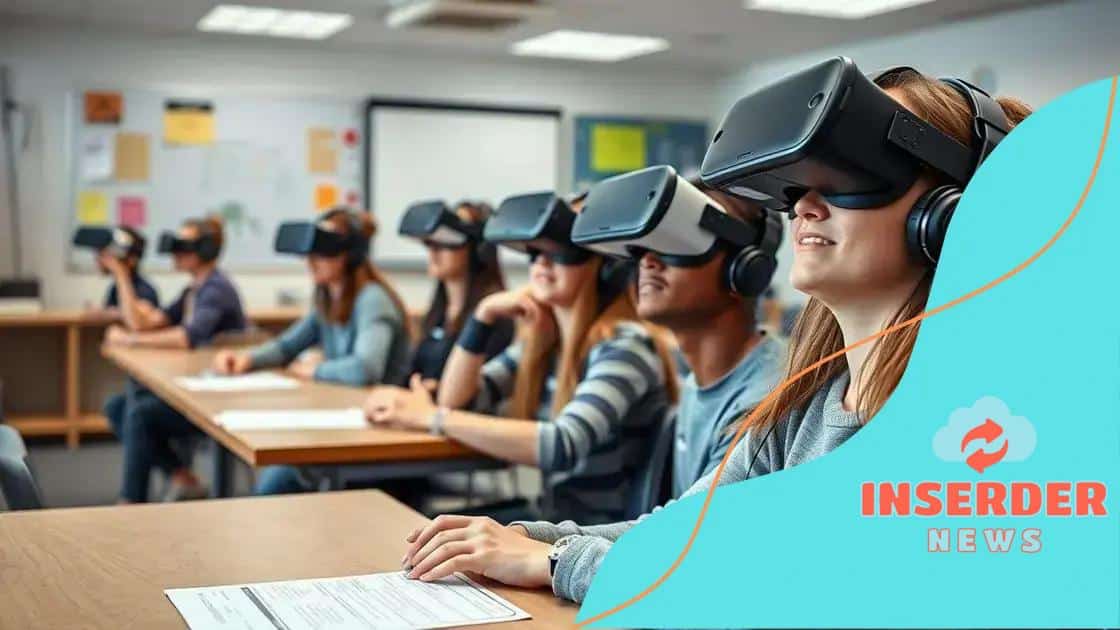Virtual reality in education: engaging students like never before

Virtual reality in education enhances student engagement and learning by providing immersive experiences that allow exploration of complex subjects through interactive environments.
Virtual reality in education is not just a buzzword; it’s transforming the way students engage with content. Imagine exploring ancient civilizations or walking through the solar system without leaving the classroom. Intrigued? Let’s dive into how this technology is reshaping education.
The basics of virtual reality in education
Understanding the basics of virtual reality in education is crucial for anyone looking to innovate in the classroom. Virtual reality (VR) allows students to experience lessons in a wholly immersive way, making complex subjects more engaging and memorable.
VR technology can transport students to different worlds, whether it’s walking through a historical site or exploring the depths of the ocean. This technology isn’t just about play; it’s about enhancing learning through experience and interaction.
What is virtual reality?
Virtual reality is a simulated experience that can be similar to or completely different from the real world. By using equipment like VR headsets and controllers, students can interact with 3D environments. This interactivity helps students grasp complex concepts better than traditional teaching methods.
Benefits of using VR in education
- Increases student engagement by providing immersive learning experiences
- Allows for practical application of theoretical knowledge
- Facilitates personalized learning at the individual pace of each student
- Encourages collaboration among peers in shared VR environments
As students engage with VR content, they often retain information better than through conventional methods. They are not just passive recipients of information but active participants in their education. This active participation fosters a deeper understanding of the material.
The application of virtual reality in classrooms can also help teachers cater to different learning styles. For visual learners, VR provides stunning visual representations, while kinesthetic learners can physically interact with educational content.
Incorporating VR into the curriculum is not without its challenges. Schools must invest in technology infrastructure and training for educators. However, many are finding that the benefits far outweigh the obstacles.
As we explore the evolution of educational tools, it is clear that virtual reality is paving a new path for learning, making classrooms more dynamic and inclusive. By leveraging this technology, we are opening up pathways that allow students to explore and learn in ways previously thought impossible.
How virtual reality enhances learning experiences
Virtual reality significantly enhances learning experiences by providing students with an interactive environment where they can explore concepts in depth. This technology engages students in a way that traditional methods often cannot, making learning more enjoyable and effective.
When students use VR, they can visualize complex theories and processes. For example, studying anatomy becomes more engaging when learners can simulate surgery or explore the human body in 3D. This immersive learning can lead to better retention of information.
Engagement through immersive environments
One of the key benefits of VR is its ability to create immersive environments. Learners can explore historical events, visit distant planets, or experience different cultures without leaving the classroom. Such experiences make lessons memorable and relevant.
Benefits of VR in learning
- Promotes active learning by allowing students to physically engage with the material.
- Enhances critical thinking as learners navigate challenges and problem-solving scenarios.
- Accommodates diverse learning styles, catering to visual, auditory, and kinesthetic learners.
- Fosters collaboration among students in shared VR experiences, encouraging teamwork.
Additionally, virtual reality can help break down geographical barriers. Students in remote areas can access high-quality educational experiences, similar to those available in urban centers. This can level the playing field and provide equal opportunities for all learners.
Teachers can also benefit from VR technology. They can use it to demonstrate complex concepts, making them easier for students to understand. Furthermore, teachers can assess students’ progress through VR simulations that provide instant feedback.
Ultimately, as education evolves, virtual reality stands out as a transformative tool. Its ability to create engaging and effective learning experiences will likely continue to grow, reshaping the future of education.
Success stories: schools embracing virtual reality

Many schools around the world are successfully embracing virtual reality to enhance their educational programs. These success stories show how VR can transform traditional learning environments into interactive and engaging experiences.
For instance, a high school in California implemented VR technology in their science curriculum. Students could explore the human body in 3D, experiencing anatomy lessons in a more tangible way. This innovation not only sparked interest but also significantly improved test scores across the board.
Schools leading the way
Educational institutions that adopt VR technology often report increased student engagement. In New York, a middle school introduced VR field trips to broaden students’ horizons. Instead of reading about the Great Wall of China, students could explore it virtually.
Positive outcomes
- Improved academic performance through experiential learning.
- Increased student motivation and participation.
- Enhanced collaboration through immersive experiences.
- Support for special education students by providing tailored learning experiences.
Moreover, one school in Texas focused on skill training for technical education. By using VR, students learned how to operate heavy machinery safely, which prepares them for future careers effectively. This hands-on experience in a controlled environment ensures safety while fostering real-world skills.
Success stories are also emerging from international schools. In Europe, several institutions have integrated VR into their language programs. Students practice speaking with virtual conversation partners, enhancing their language skills in engaging and realistic contexts.
These examples demonstrate that virtual reality is more than just a trend; it is a powerful educational tool. Schools that leverage this technology witness not only improved academic results but also enthusiastic and curious learners.
Challenges of integrating virtual reality in classrooms
Integrating virtual reality into classrooms presents several challenges that educators must navigate. While the benefits of VR are substantial, understanding these obstacles is crucial for successful implementation.
One significant challenge is the cost associated with VR technology. High-quality headsets, software, and necessary hardware can be expensive. Not all schools have the budget to invest in this technology, which may lead to inequalities in access to innovative learning tools.
Training for educators
Another hurdle includes the need for adequate training for teachers. Many educators may be unfamiliar with VR technology and its applications in the classroom. Providing professional development opportunities is essential for teachers to utilize VR effectively and integrate it into lesson plans.
Technical issues and infrastructure
- Schools may lack the necessary infrastructure, such as strong Wi-Fi connectivity and computer systems, to support VR applications.
- Technical difficulties can detract from the learning experience, leading to frustration among both students and teachers.
- Ongoing maintenance and updates can also be time-consuming and costly.
Moreover, there’s the concern about students becoming overly reliant on technology. While VR can enhance learning experiences, it’s vital to strike a balance. Students should still engage in traditional learning methods to develop critical thinking and interpersonal skills.
Lastly, ensuring a safe and healthy learning environment is crucial. Using VR too often can lead to physical discomfort, such as eye strain or headaches. Schools must create guidelines for appropriate usage to protect students’ well-being.
Despite these challenges, the push towards incorporating virtual reality in education continues. By addressing these issues head-on, schools can create better learning environments that harness the power of VR while minimizing potential drawbacks.
Future trends of virtual reality in education
The future of virtual reality in education looks promising as technology continues to evolve. Educators and students alike are excited about how VR can reshape learning experiences. Innovations in this field are leading to new possibilities that enhance how knowledge is imparted.
One major trend is the development of more accessible and affordable VR tools. As technology becomes cheaper, more schools will be able to integrate VR into their curricula. This democratization of access means that students from various backgrounds can benefit from immersive learning experiences.
Interactive learning platforms
In the coming years, we can expect to see the rise of interactive learning platforms that utilize VR. These platforms will offer a wide range of subjects, allowing students to explore topics from history to science in a virtual environment. With tailored content, students can learn at their own pace, making education more personalized.
Collaboration and social learning
- Virtual reality will enhance collaborative projects, allowing students to work together in shared virtual spaces.
- Social learning experiences can bridge geographical gaps, connecting classrooms worldwide.
- Students will engage in discussions and teamwork in immersive environments, enriching the learning experience.
Furthermore, hybrid models that combine online and in-person learning with VR are likely to gain traction. This approach allows students to experience the best of both worlds, enhancing traditional methods with immersive technology. Educators can create blended learning environments that cater to diverse learning styles.
Professional development for teachers will also evolve alongside VR technology. Educators will require continuous training to utilize new tools effectively. Professional development programs focusing on VR will become essential, enabling teachers to design innovative lesson plans.
As we look ahead, the integration of virtual reality in education will not only make learning more engaging but also foster critical skills like collaboration, communication, and creativity. With continued advancements, the classroom of the future will be interactive, dynamic, and full of opportunities for every learner.
FAQ – Frequently Asked Questions About Virtual Reality in Education
What are the benefits of using virtual reality in the classroom?
Virtual reality enhances student engagement, providing immersive experiences that make learning more interactive and enjoyable.
How do schools implement virtual reality technology?
Schools can incorporate VR by investing in hardware and software, and offering training for educators to effectively use these tools in their lessons.
What challenges do schools face when adopting virtual reality?
Challenges include high costs, lack of proper infrastructure, and the need for teacher training to effectively integrate VR into the curriculum.
What does the future hold for virtual reality in education?
The future looks promising, with advancements leading to more affordable tools, interactive learning platforms, and enhanced collaboration opportunities for students.






